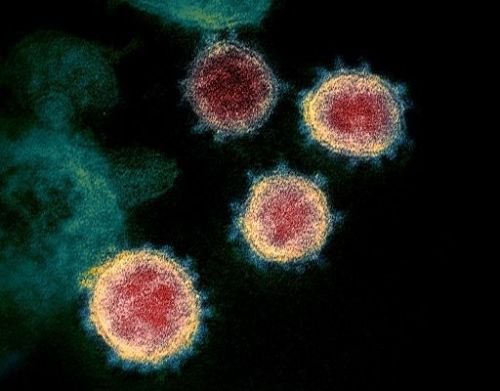Okinawan coronavirus strain that was prevalent in mid-July determined to be genetically similar to strain in Tokyo, but Okinawa Prefecture says the analysis “Does not provide a complete picture”

An image of the coronavirus captured by an electron microscope (image provided by the United States National Institute of Allergy and Infectious Diseases (NIAID))
September 9, 2020 Ryukyu Shimpo
The strain of coronavirus that spread through Okinawa’s main island in mid-July was discovered to be similar to what was being found in Tokyo. After making a request to the National Institute of Infectious Diseases, Okinawa Prefecture analyzed the virus’ genetic makeup. The disease arrived in Okinawa from outside of the prefecture and spread through the “nightlife districts,” and from restaurants and bars the disease continued to spread rapidly through homes, workplaces, and even nursing homes. Based on the analysis of virus’ genetic code, the spread of the disease in Okinawa is presumed to have arrived on the island from Tokyo.
According to the Okinawa Regional Health Division, an analysis of the genetic code of the virus for confirmed cases in Okinawa between the middle of July through the start of August showed that the strain did not belong to the group coming from the continental United States, but rather to the group of strains coming from Tokyo. However, a genetic analysis of the virus for confirmed cases in Okinawa from the first half of July has not been completed.
In Okinawa, COVID-19 cases began to rise rapidly among U.S.military personnel starting in mid-July. Since, this was shortly after Independence Day in the U.S., the spread was indicated as likely being due to parties happening on and around July 4. Whether the resurgence of cases in Okinawa came from the U.S. or Tokyo became an area of interest. Since this analysis did not cover locality or timeframe, a representative from the study indicated, “We still do not have a complete picture of the spread of the virus.”
According to the National Institute of Infectious Diseases, the first wave of the virus came in March and originated in Europe, resulting in a simultaneous nationwide cluster of infections. In mid-June, a new gene sequence of the virus was discovered in Tokyo, and many of the confirmed cases thereafter belonged to this group.
(English translation by T&CT and Sam Grieb)
Previous Article:Footage of new military base construction captured at Henoko ahead of drone restrictions
Next Article:“I have no words,” says Governor Tamaki of revelation that barbecue was cause of PFOS leak from U.S. base
[Similar Articles]
- Two new coronavirus cases confirmed on Iriomote Island, including one town employee, and insufficient healthcare on the island has its residents scared
- OPG speculates Delta variant causing rise in infections among US military-associated persons
- Cases in Okinawa Surge: “500-800 new cases per week going forward” predicted, hospital bed utilization exceeds 100% in Chubu, Main Island
- Editorial: All bases should be put on lockdown in light of 61 confirmed U.S. military coronavirus cases
- Base employees rush to get tested two weeks after cases were confirmed on base, with some calling the testing “too late” and others wanting to quit their jobs
 Webcam(Kokusai Street)
Webcam(Kokusai Street)


